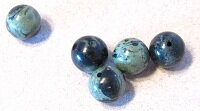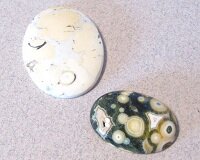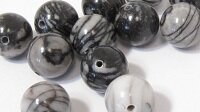Online sales are temporarily suspended !!
Contact the seller in advance before paying for the order!
Gemstones J - M

Jade:
We all probably get a picture in our heads of green, often ornamented gemstones when Jade is mentioned. And some Jade is green indeed, but it also come in several other colors.
Jade is often enhanced (stabilized) by surface waxing. It is sometimes bleached and impregnated with polymer resin, which enhances the transparency and color. Some of these gemstones are artificially stained or dyed or dyed and impregnated. Red Jade is often enhanced with heat.
The toughness of Jade is amazing, it is actually stronger than steel. Before the metals took over, they were often used in weapons, like axes, spears and knifes.
There are two types of Jade: Nephrite and Jadeite.
Nephrite:
Was in earlier times used in hard stone carving. It is softer than Jadeite with a hardness of 5,5 – 6 on the Mohs hardness scale, but is tougher than Jadeite. This Jade is normally creamy white with variations of green color.
Jadeite:
This Jade comes in several color variations like, blue, lavender – mauve, pink and emerald green. It is rarer than Nephrite, and its translucent emerald green color, named Imperial Jade, is the most prized variety. Jadeite has a hardness of 6,5 – 7. You should know that the name Jadeite sometimes is used for translucent and opaque green glass, so be cautious when buying these gemstones.
When buying Jade, you should check for joining lines under the gemstones, as they sometimes are doublets with a thin layer of Jade on top of a plastic backing or a cheaper stone. Not everything that is named Jade is the actual stone. There are many fake gemstones that are sold as Jade, or gets sold because part of the name spells Jade. So when you see some of the names below, you know that you are not getting the real ting.
Korean Jade, Suzhou Jade, Styrian Jade, Olive Jade and New Jade:
These are Serpentine, not real Jade. Serpentine Jades are not as valuable as real Jade.
African Jade and Transvaal Jade:
This is a type of Garnet that resembles Jade in color and texture.
Peach Jade:
Is a mix of Serpentine, Strictite and quartz.
Mountain Jade:
Is actually a high grade of Dolomite marble. Several colors, white, gray , peach, pink sometimes yellow colorless, green and black. With a hardness 3,5 – 4 on Mohs hardness scale these gemstones must be treated with care. It is transparent to translucent and has sometimes thin splinters. Mountain Jade is often dyed to vibrant colors. It is an economy affordable stone that can resemble Lapis Lazuli, Coral, Amethyst and of course real Jade.
Jasper:
Jasper is a form of Chalcedony and comes in several variations, colors and names. Of all Gemstones it can only be compared with Agate in diversity of colors and patterns, but its main feature is orbicular patterns, not banding like the Agates. I found it almost impossible to find out how many variations of this gemstones there are. There are buckets of Jaspers and it is almost as if new ones are discovered daily. So forgive me if you don't find the Jasper you are seeking here. There are simply too many to mention them all.
Jasper are pretty inexpensive gemstones, which often contains organic material and mineral oxides, which give them interesting patterns and coloration. Jasper has a Hardness 6,5-7 on the Mohs scale, so it is quite durable. It is a popular stone, because of its many variations, and most of them make lively features when used in jewelry.
Aqua Terra Jasper:
These are beautiful gemstones with a sort of snake skin like pattern. They combine the color of the turquoise sea and golden brown of the beach. They have to be stabilized but the colors are natural. Jasper has a hardness of 6,5 – 7 on the Mohs hardness scale.

Brecciated Jasper:
Also called Poppy Jasper when lighter. It had deep brown, brick red and cream colors. It often contains Hematite and macrocrystaline quartz in different colors. Therefore it often has a metallic luster and translucent inclusions. It's warm and deep coloration makes this a stone that can be mixed with other earth colored gemsones and is lovely with crystals. It has a hardness of 7, so it is a fairly durable stone.

Kambaba Jasper:
This stone has rich patterns of green, dark, light and medium greens with black swirls and circular patterns. It often contains fossil algae, and is sometimes called crocodile Jasper, probably because of its colors and patterns.
Autumn Jasper:
Warm brick red with avocado green pastel colors, this is a lovely stone indeed. It has a kind of shy beauty that will be enhanced with gold and crystals. Enhance it's beauty further by adding Aqua Terra Jasper beads. Autumn Jasper has a hardness of 7.

Dalmatian Jasper:
This Jasper is easy to recognize with its light yellow to cream background and black and chocolate splotches. It is warm in color, and can be lovely with other beads in gold, gold brown and mocha.
Fancy Jasper:
Mauve, cream and green. Lilac to yellow brown, rust and black, white and gray makes these very lively gemstones. Often slightly translucent they look a little waxy when polished.
Green line Jasper:
This gem has a soft green gray color that ranges from almost yellow white to moss green and black. The patterns are band-like and vary so this is, like most Jaspers an interesting and almost mystical gem. It takes a shiny polish and has a hardness of 6.5 – 7.

Leopardskin Jasper:
Its patterns have brought peoples minds to leopardskin when they named this gemstones. Probably because of the black and dark brown spots and rings on orange brown and ocher background often mixed with pink.
Mookaite Jasper:
Also written Moukaite. This Jasper commonly contains fossils of prehistoric plants. The stones range in color from pink, mauve to yellow to brick red and brown. A warm and inviting stone, that because of its wide range in coloration, does not need to be mixed with other gemstones to be enhanced. Beautiful with gold. Often used in mens jewelry.
Mustang Jasper:
This is a dark brown stone with inclusions of brick red, warm mustard and sand colors. It polishes to a nice luster.

Ocean Jasper:
Beautiful multicolored stone with orbicular patterns. Earth tones blends of brown and deep Forrest greens, rust and reds. It is unique among the Jaspers for its translucent patterns. Because of its lovely and versatile patterns it is a popular stone and is among the more expensive Jaspers,

Picasso Jasper:
Streaks of black, gray and occasionally red. At first glance it can look a bit boring, because of the dominant gray color, but when you look closer the gray is almost mauve and the black streaks really draws ones mind to ink drawings. A really lovely stone, which give more than it appears to at first glance.

Picture Jasper:
Brown, tan and cream colors to yellowish cream. It contains a combination of petrified mud in pockets of ancient volcanic rock. This leaves a pattern that often resembles a scenery or a picture, hence the name.

Pink Jasper:
This is a lovely colored stone, in warm cream yellow to soft pink with veins in darker pink to ocher.

Rainforest Jasper (Rhyolite):
This lovely stone often has orbed patterns in greens, browns and cream. Another warm and inviting stone that is full of life. Tone it down with peach Quartz to make a warm, earthy necklace, or bring it to elegance by combining it with crystal colored Swarovski bicones. You can see Rhyolite used in a bracelet here.

Red flake Jasper:
Deep brick or rust red, with streaks of black or translucent and sometimes inclusions in white or cream. The rust red color is very distinct. These are warm inviting gemstones, that can be combined with several other earth toned gems or beads to create beautiful jewelry. Try them with Unakite, Rhyolite or with Old Crazy Laze Agate.

Sesame Jasper:
This lovely Jasper is almost pistachio green in color, with translucent and black inclusions. It is the green version of Dalmatian Jasper. Because of its pastel color it is very beautiful with silver or with black gemstones like onyx. Its color and pattern is very distinct, so it is easy to recognize this gem.

Zebra Jasper:
Yeah, this one also have its name after an animal, this time the Zebra. It is a lovely black, graffiti and white stone. Sometimes sort of banded, like zebra skin.

Labradorite:
White, gray, light blue, light green, pale orange, red, black. Usually with a strong display of purple, blue and green. Hardness 6-6,5 on Mohs scale.
Labradorite has an iridescent play of colors caused by internal fractures in the mineral that reflect light back and forth, dispersing it into different colors. This effect is known as labradorescence and Labradorite is the only gem that shows this to the fullest. It is a beautiful jewelry stone. Looks dull and gray at first glance until it is viewed from the right direction.
When you buy Labradorite you can be assured that you are getting the real thing, as there are no known fake variations of these beautiful gemstones. The quality depends on the labradorescence, so if it flickers iridescent in strong colors, it is probably worth the price.

Lapis Lazuli:
Prized for their intense blue color, these gemstones have been a favorite and highly prized stone for millenniums. Highly popular in ancient Egypt and other Mediterranean countries, they have been found in graves thousands of years old.
It was even ground and used as a pigment by the old masters of oil painting, to get that very strong blue Ultramarine, that they could otherwise not achieve. It is still highly popular and seen as a high quality gemstone today. The finest color is intense blue, lightly dusted with small flecks of golden Pyrite, that makes it almost irresistible. The ones without white Clacite veins are prized as more valuable. Lapis Lazulie is often dyed to improve color.
It is a relatively rare stone, and is actually a stone, not a mineral. Because of this there are several variations of fake Lapis on the market, so you should take care when you buy this lovely stone. Even the Egyptians faked Lapis with colored glass. Today Lapis Lazuli has been successfully synthesized, and is sold with or without pyrite inclusions, at a slightly lower prize than the real gemstones.
Dyed Howlite Lolite and Jasper are often sold as Lapis, but the most convincing fake is Sodalite.
Denim Lapis Lazuli:
Blue, white and gray, with areas of Pyrite inclusions. Named after the likeness of denim. It is a lower grade of Lapis Lazuli and is widely used around the world. Hardness of 5-6 on the Mohs scale.

Lolite:
Lolite, sometimes written Iolite, is also called the viking compass stone, because the viking used lenses made of Lolite to locate the suns position, so they could navigate in the right direction. Leif Eiriksson probably discovered America from navigating with a Lolite lens. (Sorry, I just HAD to mention this. I am after all a proud Norwegian and they ARE my ancestors.)
Lolite is a transparent stone that comes in several colors like dark Violet-blue, which is the most common, light and gray blue, green and brown. Because of its transparency it is often faceted to enhance the colors.
Lolite has the ability to change color when viewed from different angles, something that is called Plechroism. With a hardness of 7 – 7,5 it is a very durable stone that can endure frequent wearing.
Because of its bluish colors it has been compared to the light blue Sapphire, and is sometimes named Water Sapphire.
Magnesite:
Magnesite is white with gray, yellowish brown veining. Its natural colors range from yellow to gray. I find that it is very similar to Howlite, and it is difficult to distinguish from Dolomite and Serpentine. It is a porous stone and adhere to the thong when licked.

The stone gives an antiqued porcelain effect, with its chalky white color. Since it is a very porous stone and has a hardness of 3,5 - 5 it needs to be polished and stabilized to improve durability.
Because of its porosity it is often dyed, and it can be difficult to distinguish a dyed Magnesite from the more expensive Turquoise. It makes a very convincing Turquoise at a more affordable prize. It is therefore sometimes called Chalk Turquoise or White Turquoise. So when you see those two names, you know that it is not real Turquoise, but Magnesite.
Magnesite is fluorescing when held under short-wave UV light. Because of its ability to imitate turquoise, these are very popular gemstones. It can be dyed in all kinds of color, and is beautiful as natural. Try to combine it with gold and crystals, or with black or brown gemstones or beads. Because it is so soft, it must be treated with care. Clean it in water and wipe it with a soft cloth. When storing it, a soft string pouch will keep it from scratching and contamination.
You can see Magnesite used for a necklace in this tutorial.
Malachite:
Malachite is easy to recognize because of its strong green colors that ranges from light to very dark. It is opaque but may have translucent thin splinters. It is beautiful banded and makes amazing beads and cabochons when cut and polished. Because of its striking banding and coloration it is often carved into ornaments.
Malachite has been used in jewelry for thousands of years. Its name is Greek, but there are some controversy about from which word. Some say it is the word Malacos which mean soft, and other the word Mallow, which mean green herb. Both names fits the stones properties, since it is very green and has a hardness of only 3,5 – 4.
Because it is so soft, caution must be taken not to scratch or damaging the stone. It should not be used in everyday worn jewelry, and should not be cleaned with an ultrasonic cleaner. It is often impregnated with polymer resin to protect it, and washing it in water may remove this coating.
Malachite is lovely with silver. Because of its strong coloration, it is very dominant, and look its best with toned down beads or pearls.

Red Malachite:
This is a very popular semi precious stone, but is not a Malachite, but a Jasper. It is banded and has a beautiful creamy red color with terra cotta colored bands. Its distinct banding resembles those of real Malachite, and is the reason it is called Red Malachite and not Red Jasper. Because it is a Jasper, it is more durable than green Malachite, and has a hardness of 6,5 – 7.
The coloration is truly beautiful, soft and warm. Mix it with Unakite and silver to make a tranquil and lovely piece of jewelry.

Moonstone:
Describes any variety of feldspar with and adularescent sheen. The sheen is caused by light reflecting internally in the moon stone, because of layered inclusions of different Felspars. This is a popular gemstone and comes in an assortment of colors like white, yellow, orange and reddish, but the colorless to light blue is the most common one.
It is said to have gotten its name from its resemblance to the silvery moon. The most valuable ones have a blue sheen, perfect clarity and a colorless body. They are becoming rare though so the prize rises accordingly to the lack of new deposits. How ever, you can get them in all kinds of qualities and prizes.
Some moonstones have a cat's eye effect and others are cut into cameos. They are mostly cut in cabochons though, to best show the adularescence. The adularescent ones are called Rainbow Moonstone. Moonstone has a hardness of 6 – 6,5, so it should be treated with some care, as it scratches easily, and are sensitive to pressure. The gem needs no enhancements. Moonglow Lucite was used in the first half of the 20 century to imitate moonstone.
Return from Gemstones J-M to Gemstones
Go to Home Page
Gems A
Gems B-I
Leave a comment ,
I would love to hear your opinion on this page. Good or bad, it will help me making this Site better.






















